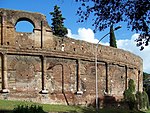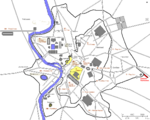Museo nazionale degli strumenti musicali
Italian museum stubsMuseums in RomeMusic museums in ItalyMusical instrument museums in ItalyNational museums of Italy

The National Museum of Musical Instruments is situated in the Palazzina Samoggia in Rome. The museum, owned by the MIBACT since December 2014 is one of 43 museums pertaining to the Polo museale del Lazio. The museum had 9,164 visitors in 2015.
Excerpt from the Wikipedia article Museo nazionale degli strumenti musicali (License: CC BY-SA 3.0, Authors, Images).Museo nazionale degli strumenti musicali
Piazza di Santa Croce in Gerusalemme, Rome Municipio Roma I
Geographical coordinates (GPS) Address Nearby Places Show on map
Geographical coordinates (GPS)
| Latitude | Longitude |
|---|---|
| N 41.8889 ° | E 12.5147 ° |
Address
Santa Croce in Gerusalemme
Piazza di Santa Croce in Gerusalemme
00182 Rome, Municipio Roma I
Lazio, Italy
Open on Google Maps










